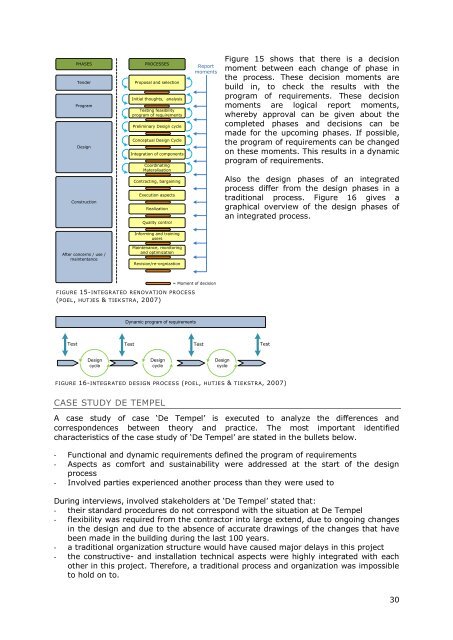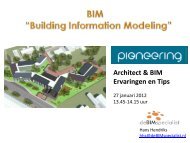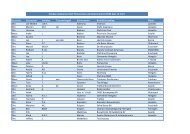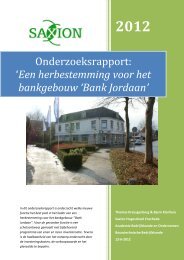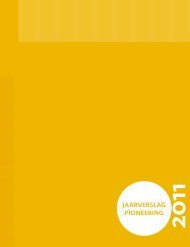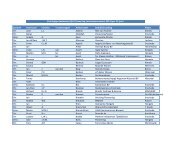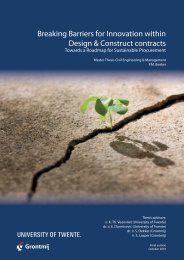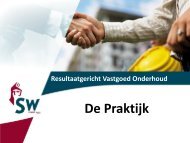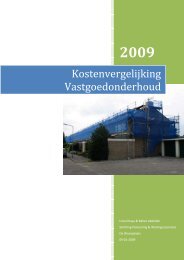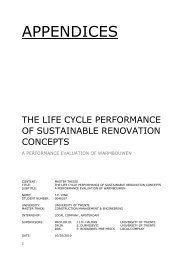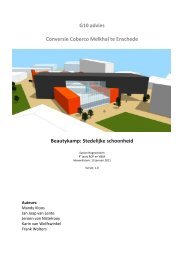the life cycle performance of sustainable renovation concepts
the life cycle performance of sustainable renovation concepts
the life cycle performance of sustainable renovation concepts
- No tags were found...
You also want an ePaper? Increase the reach of your titles
YUMPU automatically turns print PDFs into web optimized ePapers that Google loves.
PHASESTenderProgramDesignConstructionPROCESSESProposal and selectionInitial thoughts, analysisTesting feasibilityprogram <strong>of</strong> requirementsPreliminary Design <strong>cycle</strong>Conceptual Design CycleIntegration <strong>of</strong> componentsCoordinatingMateralisationContracting, bargainingExecution aspectsRealizationQuality controlReportmomentsFigure 15 shows that <strong>the</strong>re is a decisionmoment between each change <strong>of</strong> phase in<strong>the</strong> process. These decision moments arebuild in, to check <strong>the</strong> results with <strong>the</strong>program <strong>of</strong> requirements. These decisionmoments are logical report moments,whereby approval can be given about <strong>the</strong>completed phases and decisions can bemade for <strong>the</strong> upcoming phases. If possible,<strong>the</strong> program <strong>of</strong> requirements can be changedon <strong>the</strong>se moments. This results in a dynamicprogram <strong>of</strong> requirements.Also <strong>the</strong> design phases <strong>of</strong> an integratedprocess differ from <strong>the</strong> design phases in atraditional process. Figure 16 gives agraphical overview <strong>of</strong> <strong>the</strong> design phases <strong>of</strong>an integrated process.Informing and trainingusersAfter concerns / use /maintentanceMaintenance, monitoringand optimizationRevision/re-orgnization= Moment <strong>of</strong> decisionFIGURE 15-INTEGRATED RENOVATION PROCESS(POEL, HUTJES & TIEKSTRA, 2007)Dynamic program <strong>of</strong> requirementsTest Test Test TestDesign<strong>cycle</strong>Design<strong>cycle</strong>Design<strong>cycle</strong>FIGURE 16-INTEGRATED DESIGN PROCESS (POEL, HUTJES & TIEKSTRA, 2007)CASE STUDY DE TEMPELA case study <strong>of</strong> case „De Tempel‟ is executed to analyze <strong>the</strong> differences andcorrespondences between <strong>the</strong>ory and practice. The most important identifiedcharacteristics <strong>of</strong> <strong>the</strong> case study <strong>of</strong> „De Tempel‟ are stated in <strong>the</strong> bullets below.- Functional and dynamic requirements defined <strong>the</strong> program <strong>of</strong> requirements- Aspects as comfort and sustainability were addressed at <strong>the</strong> start <strong>of</strong> <strong>the</strong> designprocess- Involved parties experienced ano<strong>the</strong>r process than <strong>the</strong>y were used toDuring interviews, involved stakeholders at „De Tempel‟ stated that:- <strong>the</strong>ir standard procedures do not correspond with <strong>the</strong> situation at De Tempel- flexibility was required from <strong>the</strong> contractor into large extend, due to ongoing changesin <strong>the</strong> design and due to <strong>the</strong> absence <strong>of</strong> accurate drawings <strong>of</strong> <strong>the</strong> changes that havebeen made in <strong>the</strong> building during <strong>the</strong> last 100 years.- a traditional organization structure would have caused major delays in this project- <strong>the</strong> constructive- and installation technical aspects were highly integrated with eacho<strong>the</strong>r in this project. Therefore, a traditional process and organization was impossibleto hold on to.30


